High Brightness Ce:Nd:YAG Solar Laser Pumping Approach with 22.9 W/m2 TEM00-Mode Collection Efficiency
Abstract
:1. Introduction
2. Ce:Nd:YAG SPL
2.1. Heliostat-Parabolic Mirror System at PROMES-CNRS for Solar Energy Collection and Concentration
2.2. Ce:Nd:YAG Solar Laser Head
3. Ce:Nd:YAG Solar Laser Head Numerical Optimization
3.1. Zemax® Ray Tracing Analysis
3.2. LASCADTM Analysis
4. Multimode Solar Laser Power Analysis
5. TEM00-Mode Solar Laser Power Analysis
6. Conclusions
Author Contributions
Funding
Data Availability Statement
Acknowledgments
Conflicts of Interest
References
- Lando, M.; Kagan, J.A.; Shimony, Y.; Kalisky, Y.Y.; Noter, Y.; Yogev, A.; Rotman, S.R.; Rosenwaks, S. Solar-pumped solid state laser program. In Proceedings of the 10th Meeting on Optical Engineering in Israel, Jerusalem, Israel, 2–6 March 1997; Volume 3110. [Google Scholar]
- Vasile, M.; Maddock, C.A. Design of a formation of solar pumped lasers for asteroid deflection. Adv. Space Res. 2012, 50, 891–905. [Google Scholar] [CrossRef] [Green Version]
- Yamada, N.; Ito, T.; Ito, H.; Motohiro, T.; Takeda, Y. Crystalline silicon photovoltaic cells used for power transmission from solar-pumped lasers: III. Prototype for proof of the light trapping concept. Jpn. J. Appl. Phys. 2018, 57, 08RF07. [Google Scholar] [CrossRef]
- Kiss, Z.J.; Lewis, H.R.; Duncan, R.C. Sun pumped continuous optical maser. Appl. Phys. Lett. 1963, 2, 93–94. [Google Scholar] [CrossRef]
- Young, C.G. A Sun-Pumped cw One-Watt Laser. Appl. Opt. 1966, 5, 993–997. [Google Scholar] [CrossRef] [PubMed]
- Lando, M.; Shimony, Y.; Benmair, R.M.J.; Abramovich, D.; Krupkin, V.; Yogev, A. Visible solar-pumped lasers. Opt. Mater. 1999, 13, 111–115. [Google Scholar] [CrossRef]
- Arashi, H.; Oka, Y.; Sasahara, N.; Kaimai, A.; Ishigame, M. A Solar-Pumped cw 18 W Nd:YAG Laser. Jpn. J. Appl. Phys. 1984, 23, 1051–1053. [Google Scholar] [CrossRef]
- Weksler, M.; Shwartz, J. Solar-pumped solid-state lasers. IEEE J. Quantum Electron. 1988, 24, 1222–1228. [Google Scholar] [CrossRef]
- Lando, M.; Kagan, J.; Linyekin, B.; Dobrusin, V. A solar-pumped Nd:YAG laser in the high collection efficiency regime. Opt. Commun. 2003, 222, 371–381. [Google Scholar] [CrossRef]
- Dinh, T.H.; Ohkubo, T.; Yabe, T.; Kuboyama, H. 120 watt continuous wave solar-pumped laser with a liquid light-guide lens and an Nd:YAG rod. Opt. Lett. 2012, 37, 2670–2672. [Google Scholar] [CrossRef]
- Liang, D.; Almeida, J. Solar-Pumped TEM00 Mode Nd:YAG laser. Opt. Express 2013, 21, 25107. [Google Scholar] [CrossRef]
- Vistas, C.R.; Liang, D.; Almeida, J.; Guillot, E. TEM00 mode Nd:YAG solar laser by side-pumping a grooved rod. Opt. Commun. 2016, 366, 50–56. [Google Scholar] [CrossRef]
- Liang, D.; Almeida, J.; Vistas, C.R.; Oliveira, M.; Goncalves, F.; Guillot, E. High-efficiency solar-pumped TEM00-mode Nd:YAG laser. Sol. Energy Mater. Sol. Cells 2016, 145, 397–402. [Google Scholar] [CrossRef]
- Liang, D.; Almeida, J.; Vistas, C.R.; Guillot, E. Solar-pumped Nd:YAG laser with 31.5 W/m2 multimode and 7.9 W/m2 TEM00-mode collection efficiencies. Sol. Energy Mater. Sol. Cells 2017, 159, 435–439. [Google Scholar] [CrossRef]
- Guan, Z.; Zhao, C.; Li, J.; He, D.; Zhang, H. 32.1 W/m2 continuous wave solar-pumped laser with a bonding Nd:YAG/YAG rod and a Fresnel lens. Opt. Laser Technol. 2018, 107, 158–161. [Google Scholar] [CrossRef]
- Liang, D.; Vistas, C.R.; Tiburcio, B.D.; Almeida, J. Solar-pumped Cr:Nd:YAG ceramic laser with 6.7% slope efficiency. Sol. Energy Mater. Sol. Cells 2018, 185, 75–79. [Google Scholar] [CrossRef]
- Vistas, C.R.; Liang, D.; Almeida, J.; Tibúrcio, B.D.; Garcia, D. Adoughnut-shaped Nd:YAG solar laser beam with 4.5 W/m2 collection efficiency. Sol. Energy 2019, 182, 42–47. [Google Scholar] [CrossRef]
- Liang, D.; Vistas, C.R.; Almeida, J.; Tiburcio, B.D.; Garcia, D. Side-pumped continuous-wave Nd:YAG solar laser with 5.4% slope efficiency. Sol. Energy Mater. Sol. Cells 2019, 192, 147–153. [Google Scholar] [CrossRef]
- Vistas, C.R.; Dawei, L.; Joana, A.; Bruno, D.T.; Dário, G.; Miguel, C.; Hugo, C.; Emmanuel, G. Ce:Nd:YAG side-pumped solar laser. J. Photon. Energy 2021, 11, 018001. [Google Scholar] [CrossRef]
- Tai, Y.; Zheng, G.; Wang, H.; Bai, J. Near-infrared quantum cutting of Ce3+–Nd3+ co-doped Y3Al5O12 crystal for crystalline silicon solar cells. J. Photochem. Photobiol. A Chem. 2015, 303–304, 80–85. [Google Scholar] [CrossRef]
- Yagi, H.; Yanagitani, T.; Yoshida, H.; Nakatsuka, M.; Ueda, K. The optical properties and laser characteristics of Cr3+ and Nd3+ co-doped Y3Al5O12 ceramics. Opt. Laser Technol. 2007, 39, 1295–1300. [Google Scholar] [CrossRef]
- Guo, Y.; Huang, J.; Ke, G.; Ma, Y.; Quan, J.; Yi, G. Growth and optical properties of the Nd,Ce:YAG laser crystal. J. Lumin. 2021, 236, 118134. [Google Scholar] [CrossRef]
- Payziyev, S.; Sherniyozov, A.; Bakhramov, S.; Zikrillayev, K.; Khalikov, G.; Makhmudov, K.; Ismailov, M.; Payziyeva, D. Luminescence sensitization properties of Ce: Nd: YAG materials for solar pumped lasers. Opt. Commun. 2021, 499, 127283. [Google Scholar] [CrossRef]
- Garcia, D.; Liang, D.; Vistas, C.R.; Costa, H.; Catela, M.; Tibúrcio, B.D.; Almeida, J. Ce:Nd:YAG Solar Laser with 4.5% Solar-to-Laser Conversion Efficiency. Energies 2022, 15, 5292. [Google Scholar] [CrossRef]
- Liang, D.; Vistas, C.R.; Garcia, D.; Tibúrcio, B.D.; Catela, M.; Costa, H.; Guillot, E.; Almeida, J. Most efficient simultaneous solar laser emissions from three Ce:Nd:YAG rods within a single pump cavity. Sol. Energy Mater. Sol. Cells 2022, 246, 111921. [Google Scholar] [CrossRef]
- ASTM G173-03; Standard Tables for Reference Solar Spectral Irradiances: Direct Normal and Hemispherical on 37° Tilted Surface. ASTM International: West Conshohocken, PA, USA, 2012.
- Vistas, C.R.; Liang, D.; Garcia, D.; Tibúrcio, B.D.; Almeida, J. 32 W TEM00-Mode Side-Pumped Solar Laser Design. Appl. Sol. Energy 2020, 56, 449–457. [Google Scholar] [CrossRef]
- Wang, L.; Xia, C.; Xu, P.; Di, J.; Sai, Q.; Mou, F. Energy transfer in Ce, Nd, and Yb co-doped YAG phosphors. Chin. Opt. Lett. 2013, 11, 061604. [Google Scholar] [CrossRef]
- Ciofini, M.; Favilla, E.; Lapucci, A.; Sani, E. Propagation parameters of the beam extracted from a diode pumped Nd:YAG ceramic slab laser with a hybrid stable–unstable resonator. Opt. Laser Technol. 2007, 39, 1380–1388. [Google Scholar] [CrossRef]
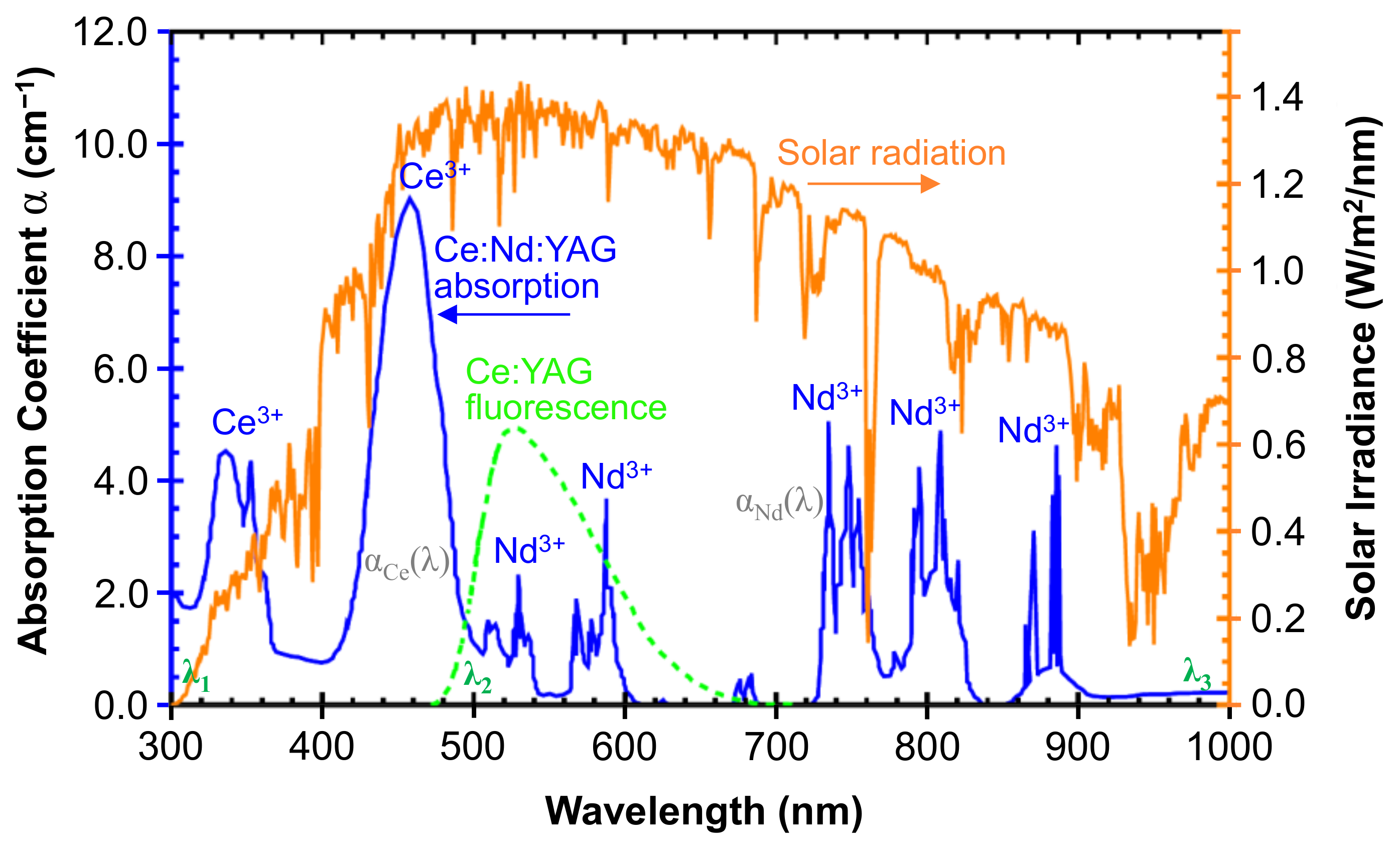

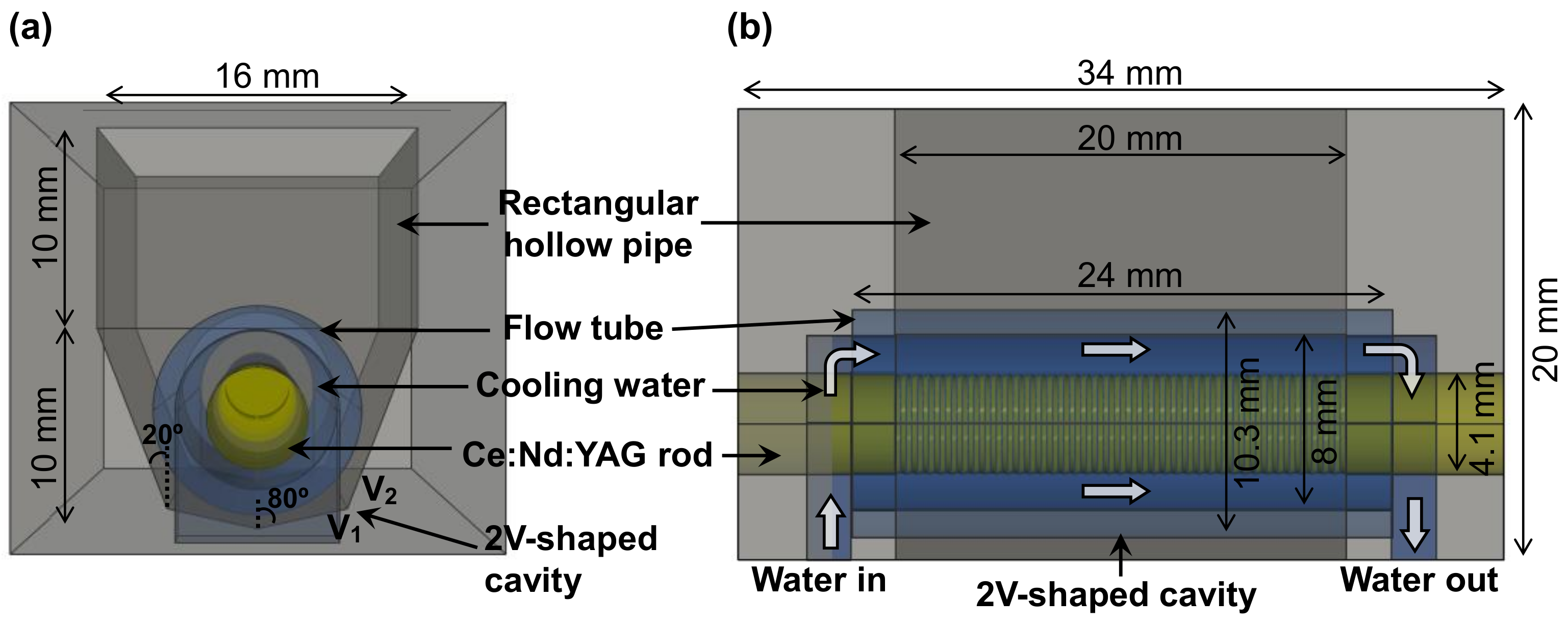
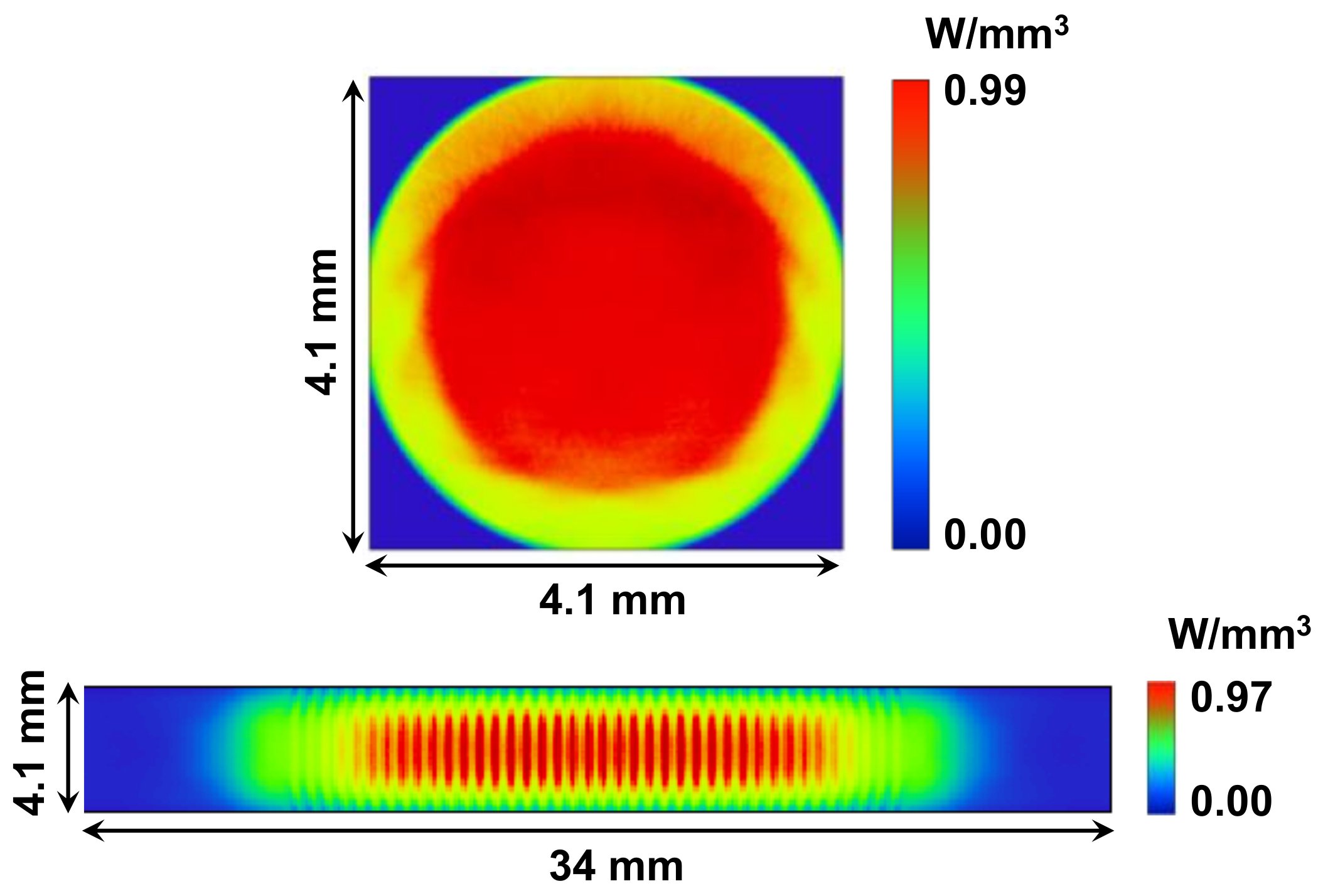
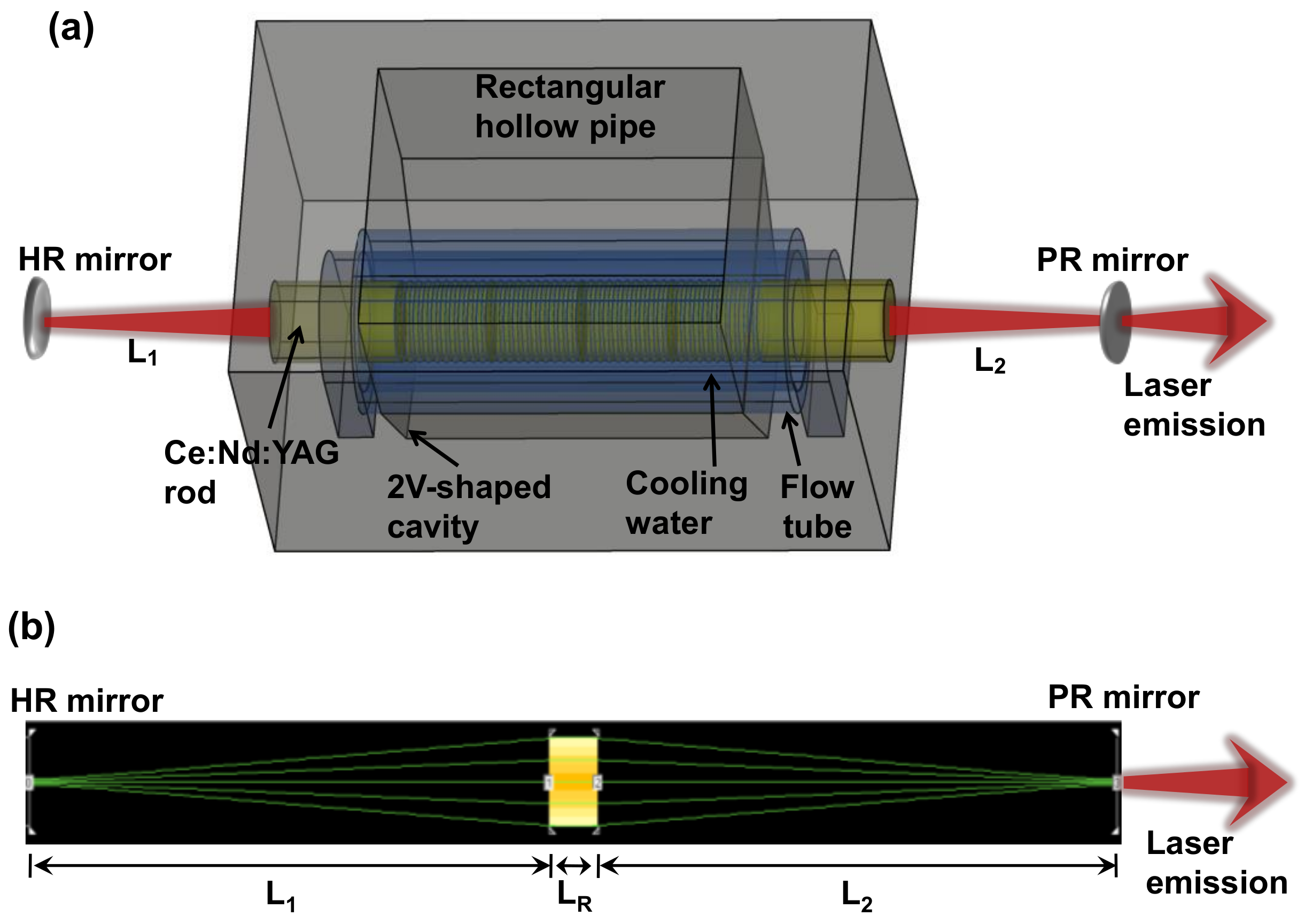
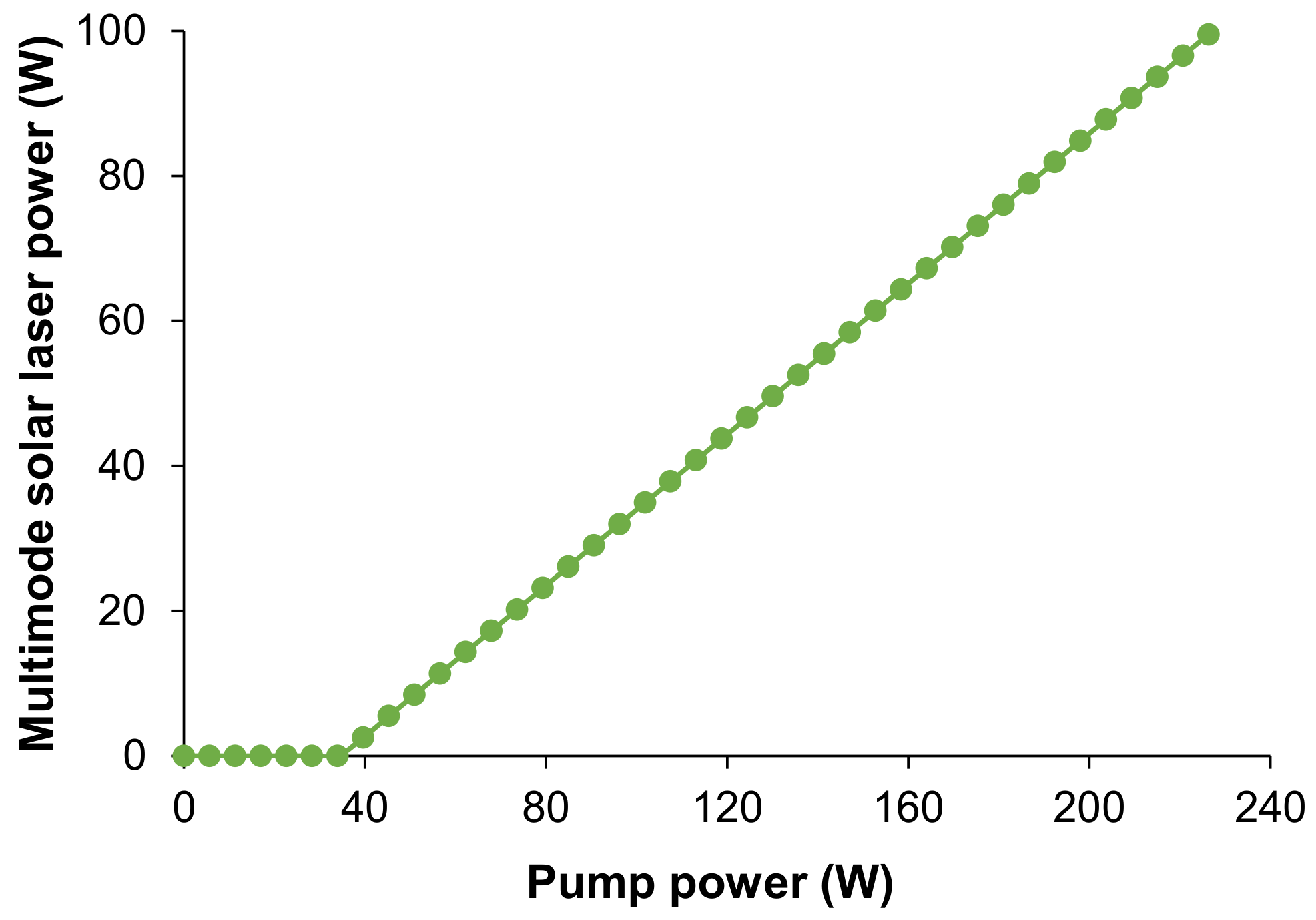
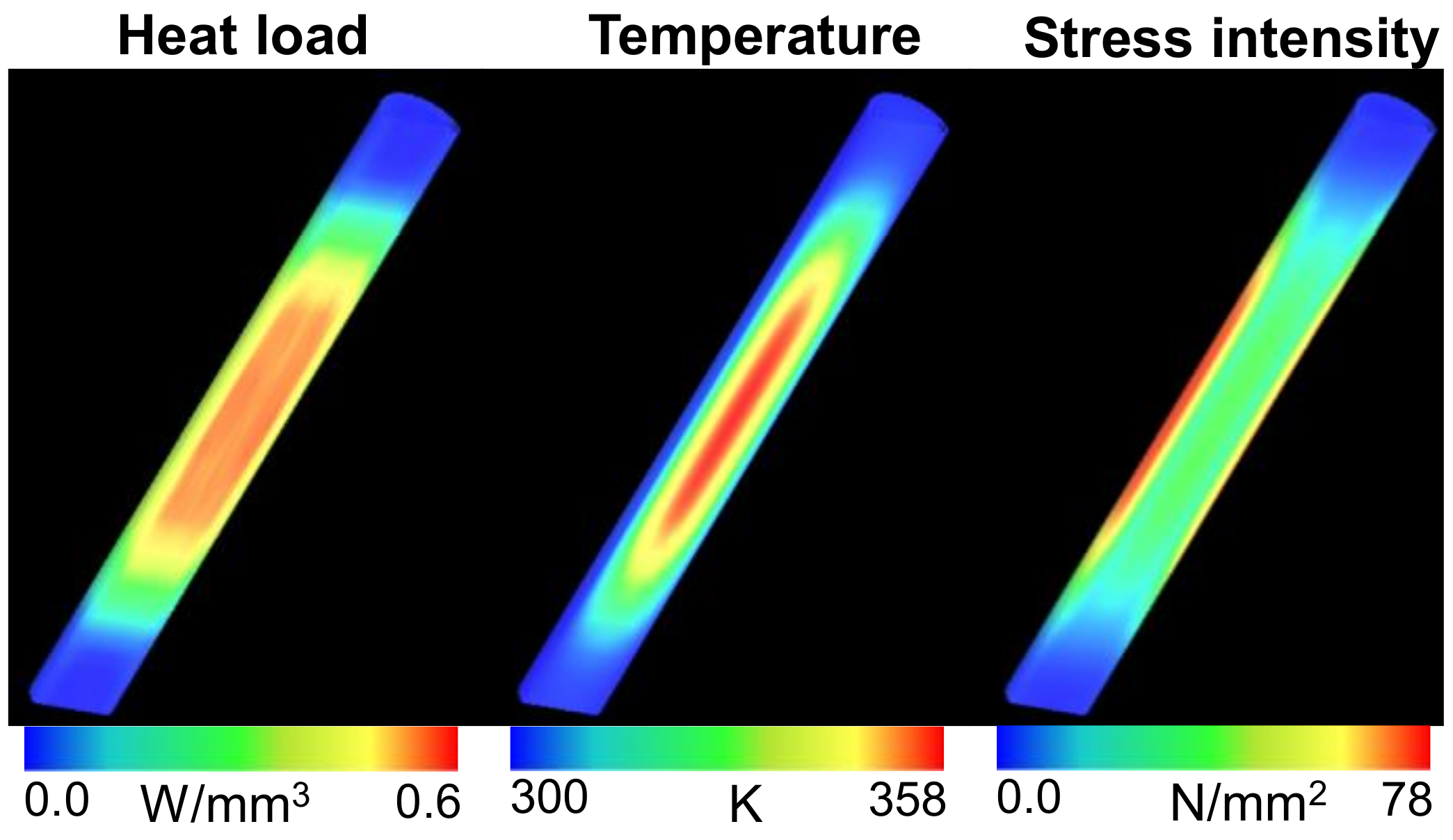
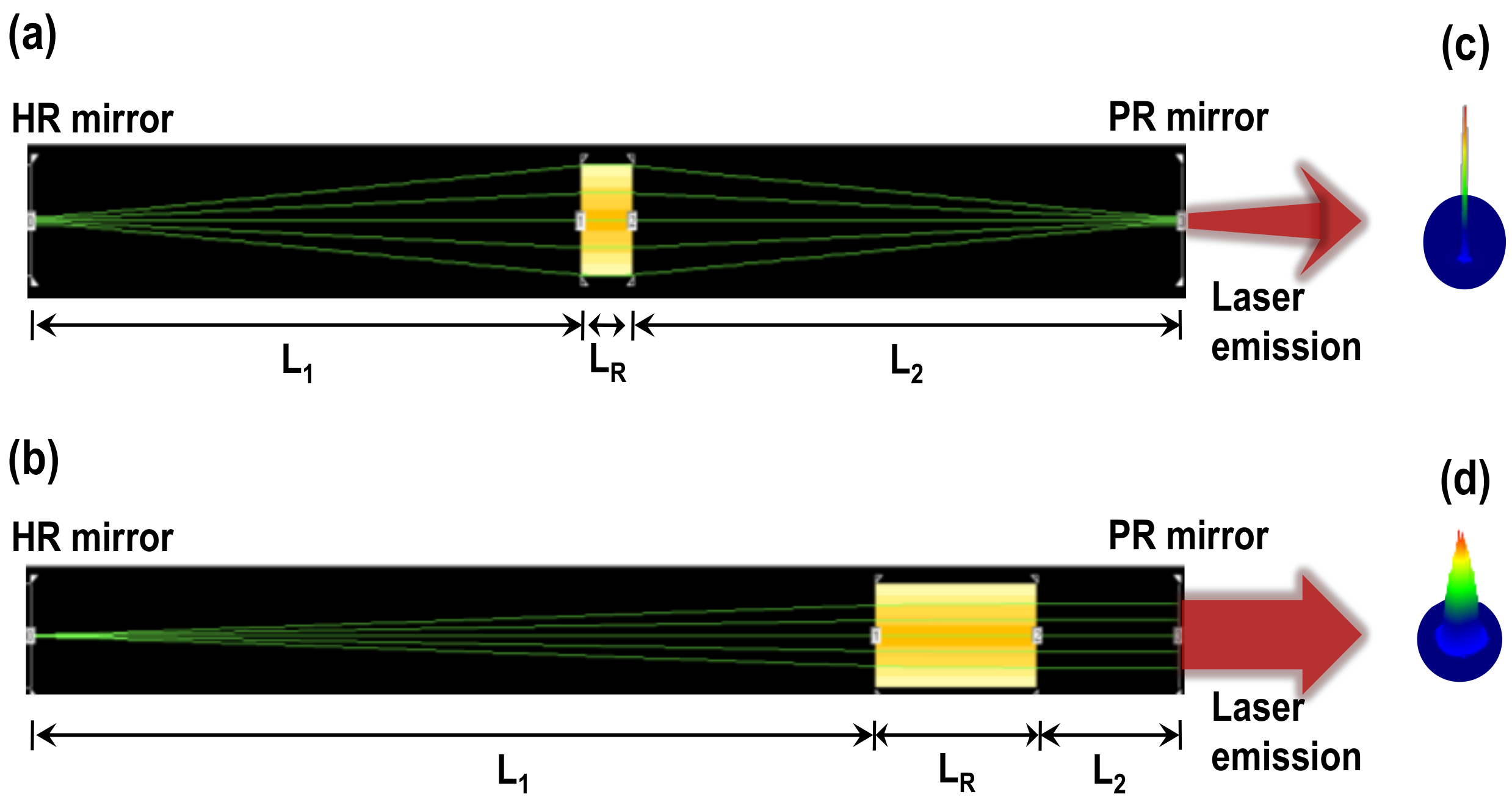
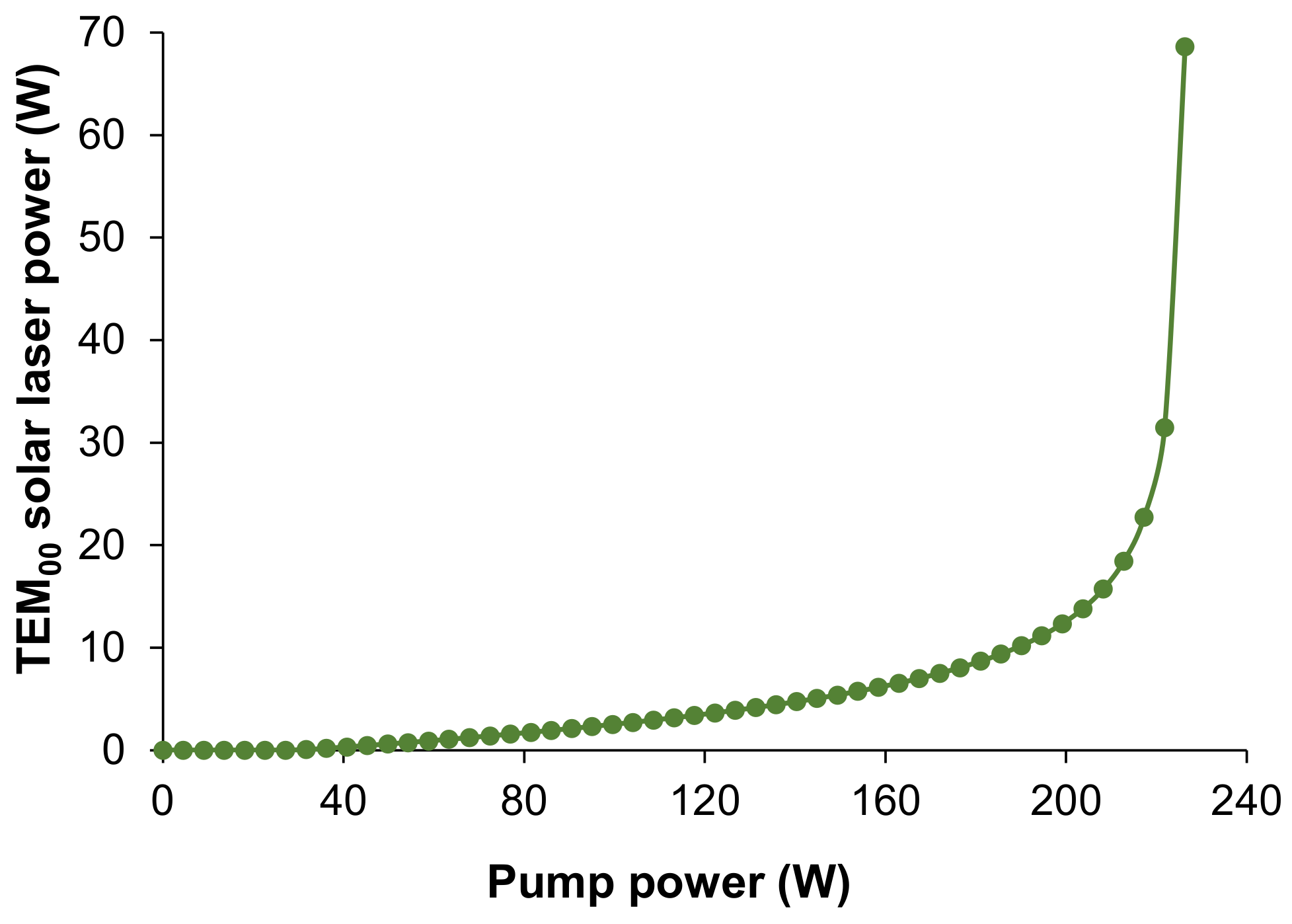
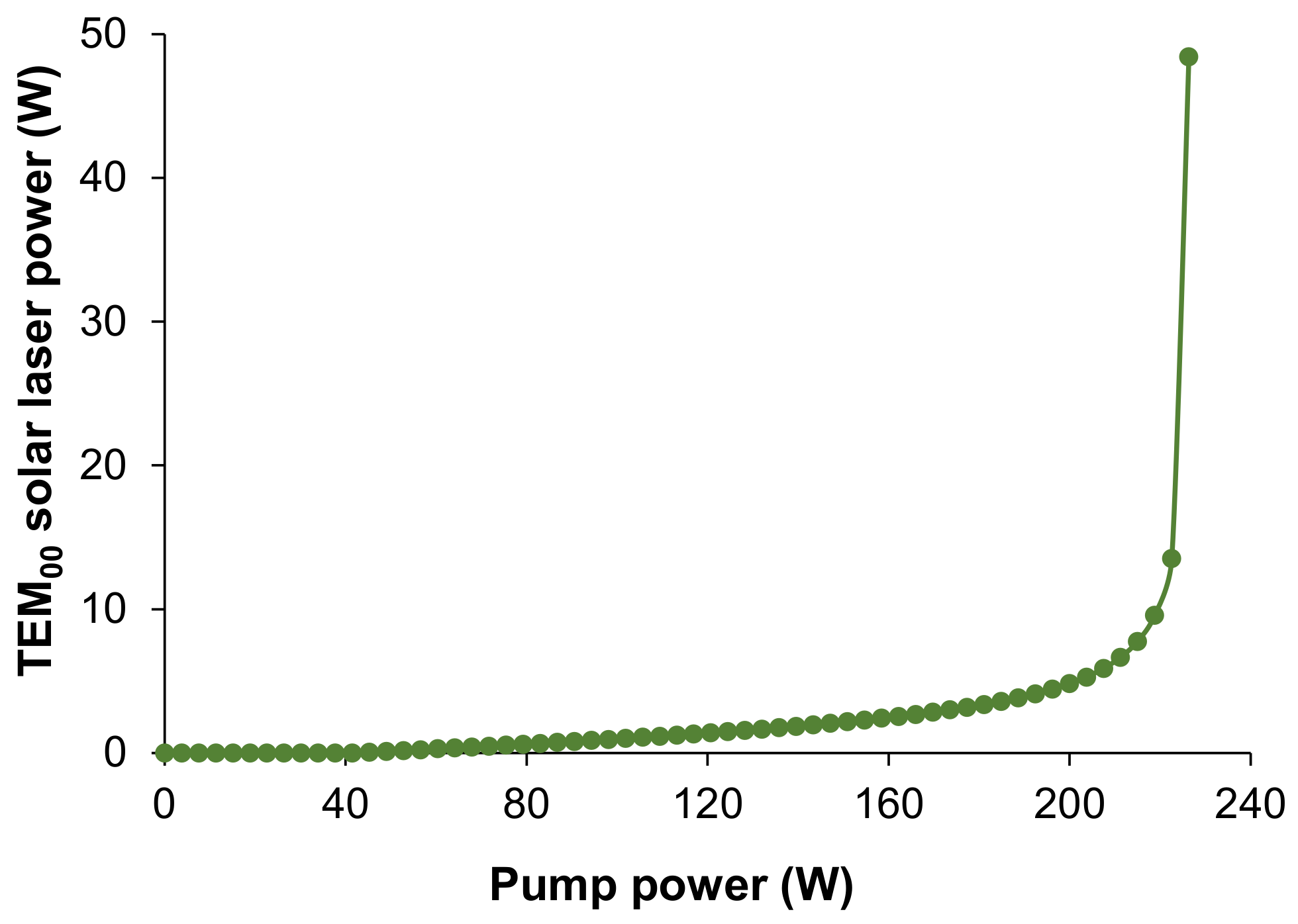

Disclaimer/Publisher’s Note: The statements, opinions and data contained in all publications are solely those of the individual author(s) and contributor(s) and not of MDPI and/or the editor(s). MDPI and/or the editor(s) disclaim responsibility for any injury to people or property resulting from any ideas, methods, instructions or products referred to in the content. |
© 2023 by the authors. Licensee MDPI, Basel, Switzerland. This article is an open access article distributed under the terms and conditions of the Creative Commons Attribution (CC BY) license (https://creativecommons.org/licenses/by/4.0/).
Share and Cite
Vistas, C.R.; Liang, D.; Costa, H.; Catela, M.; Garcia, D.; Tibúrcio, B.D.; Almeida, J. High Brightness Ce:Nd:YAG Solar Laser Pumping Approach with 22.9 W/m2 TEM00-Mode Collection Efficiency. Energies 2023, 16, 5143. https://doi.org/10.3390/en16135143
Vistas CR, Liang D, Costa H, Catela M, Garcia D, Tibúrcio BD, Almeida J. High Brightness Ce:Nd:YAG Solar Laser Pumping Approach with 22.9 W/m2 TEM00-Mode Collection Efficiency. Energies. 2023; 16(13):5143. https://doi.org/10.3390/en16135143
Chicago/Turabian StyleVistas, Cláudia R., Dawei Liang, Hugo Costa, Miguel Catela, Dário Garcia, Bruno D. Tibúrcio, and Joana Almeida. 2023. "High Brightness Ce:Nd:YAG Solar Laser Pumping Approach with 22.9 W/m2 TEM00-Mode Collection Efficiency" Energies 16, no. 13: 5143. https://doi.org/10.3390/en16135143




